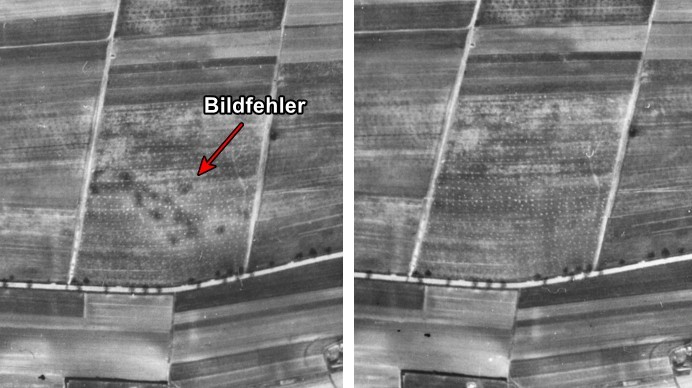Allied bombing used various types of dropped munitions, such as explosive, incendiary, fragmentation bombs and aerial mines.
In a previous article, the topic of explosive bomb craters, their appearance and recognisability, as well as the use of historical aerial photographs for explosive ordnance reconnaissance were explained. This article will now deal with further aspects of the topic of explosive bombs (mode of action, ignition and the importance of multi-temporal, stereoscopic aerial image evaluation).
The primary aim of explosive bombs is to cause damage through the blast effect and the shock wave. The detonators of these bombs can be set to explode immediately on contact with the ground or only after a delay of fractions of a second. A special type of detonator is a long-life chemical detonator that detonates an explosive bomb several hours after it has been dropped, thus hindering clean-up and recovery operations after an air raid. Explosive bombs with long-life detonators pose a particular problem for explosive ordnance disposal today, as it is not possible to tell from the outside how far the chemical triggering process has progressed. These unexploded bombs are usually no longer defused but directly detonated in a controlled manner.
An important aspect in the detection of explosive bomb funnels is the application of digital 3D technologies with stereoscopic evaluation methods. A stereoscopic view of aerial image pairs of an image flight makes it easier to decide whether a supposedly detected funnel is actually a hollow or solid shape (e.g. haystacks or trees). Through a monoscopic view, this is often not possible without doubt. Besides the possibility of a stereoscopic evaluation, the acquisition of aerial image pairs is also important with regard to the recognisability of image errors. Without a comparison image from the same image flight, it is often difficult to determine whether a bright spot, for example, is a filled funnel or an image defect.
If the aerial photographs to be evaluated were taken directly after an air raid or a few days later, explosive bomb craters are usually easy to recognise. The greater the time interval between the aerial photographs and an air raid, the greater the probability that explosive bomb craters have been backfilled and other war damage removed. For this reason, care is taken to obtain aerial photographs taken as soon as possible after an air raid. In this context, it makes sense to research before obtaining aerial photographs which war events took place in the area to be evaluated (air raids, ground battles).
Some objects recognised in aerial photographs cannot always be clearly identified as war damage (bomb craters, building damage). Here, a comparison with aerial photographs from a time before the first air raids can provide helpful information.
In conclusion, it can be said that a multitemporal, stereoscopic aerial image evaluation is an elementary component of a reliable detection of objects suspected of containing explosive ordnance.
At Mull und Partner, war aerial photographs are evaluated by qualified specialists with many years of experience. Digital 3D aerial image evaluation is an integral part of project processing.
The 1st image example shows an explosive bomb funnel that was filled in a short time and is no longer recognisable in the following aerial time slice.


The 2nd image example shows supposed explosive bomb funnels, which turned out to be image errors when compared with a follow-up aerial photograph.



